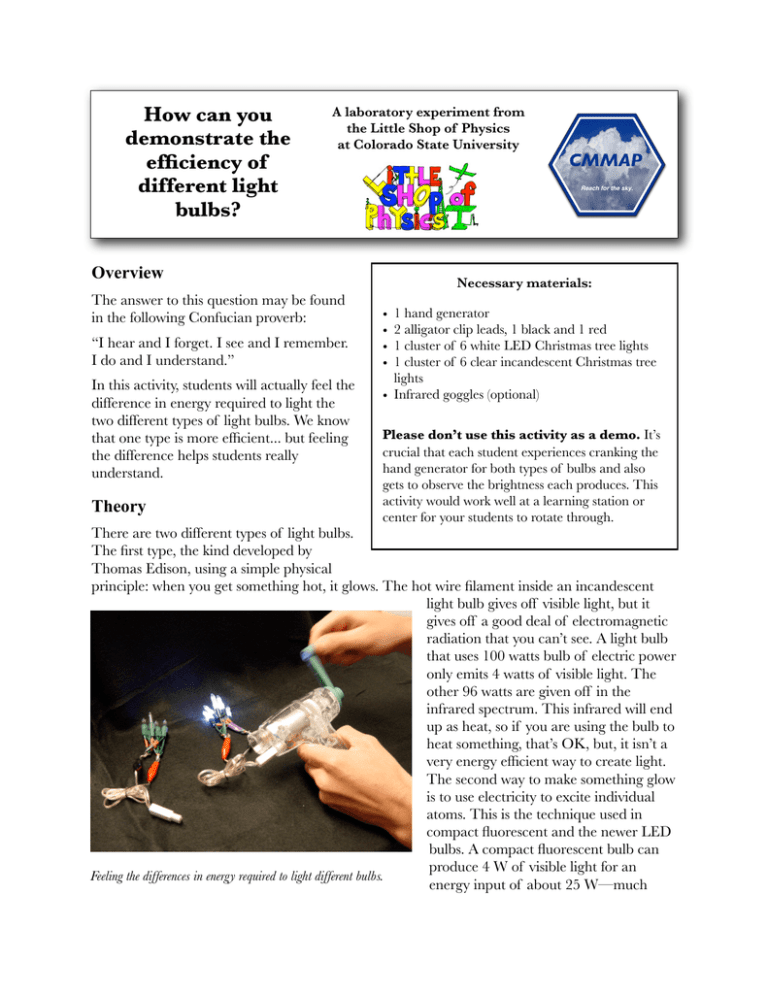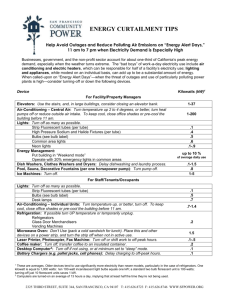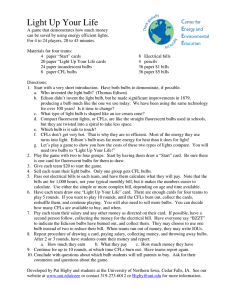How can you demonstrate the efficiency of different light
advertisement

How can you demonstrate the efficiency of different light bulbs? A laboratory experiment from the Little Shop of Physics at Colorado State University Reach for the sky. Overview The answer to this question may be found in the following Confucian proverb: “I hear and I forget. I see and I remember. I do and I understand.” In this activity, students will actually feel the difference in energy required to light the two different types of light bulbs. We know that one type is more efficient... but feeling the difference helps students really understand. Theory CMMAP Necessary materials: 1 hand generator 2 alligator clip leads, 1 black and 1 red 1 cluster of 6 white LED Christmas tree lights 1 cluster of 6 clear incandescent Christmas tree lights • Infrared goggles (optional) • • • • Please don’t use this activity as a demo. It’s crucial that each student experiences cranking the hand generator for both types of bulbs and also gets to observe the brightness each produces. This activity would work well at a learning station or center for your students to rotate through. There are two different types of light bulbs. The first type, the kind developed by Thomas Edison, using a simple physical principle: when you get something hot, it glows. The hot wire filament inside an incandescent light bulb gives off visible light, but it gives off a good deal of electromagnetic radiation that you can’t see. A light bulb that uses 100 watts bulb of electric power only emits 4 watts of visible light. The other 96 watts are given off in the infrared spectrum. This infrared will end up as heat, so if you are using the bulb to heat something, that’s OK, but, it isn’t a very energy efficient way to create light. The second way to make something glow is to use electricity to excite individual atoms. This is the technique used in compact fluorescent and the newer LED bulbs. A compact fluorescent bulb can produce 4 W of visible light for an Feeling the differences in energy required to light different bulbs. energy input of about 25 W—much more efficient! LED bulbs are more efficient yet. In this experiment, students will light two different types of bulbs using a generator to provide the power. Students will see that the bulbs are equally bright, but making this light with incandescent bulbs takes much more power input, and so they’ll need to work quite a bit harder. Doing the Experiment Tell students that they have two jobs to do in this experiment. First they will watch and observe which of the two lights (the incandescent lights or the LED lights) seems brightest to them. Without telling anyone else, they should jot their observations in their notebooks. Secondly, they will each crank the hand generator for both sets of lights and decide which set of lights they think is more energy efficient and why. They should also record this information in their notebooks. Before they begin, demonstrate how to attach the alligator clip leads to the two nails (electrodes) on the hand generator. Explain that you are attaching the black clip lead to the top nail and that this is the negative end. Now attach the red alligator clip lead to the other electrode, the positive end. Show them how to attach the red lead to one end of the incandescent cluster and the black lead to the other end. Explain that they will crank the generator and take notes on the bulb brightness and how it felt to crank it. Explain that when they hook up the LED bulb cluster, one end of the cluster is marked positive and the other negative. They will need to hook these ends up accordingly, as in LEDs, the electricity only flows in one direction. Before they begin, you will probably want to create a cranking rhythm, so your students are all turning the generators at a similar rate. Some teachers play music so that students crank to the beat. After all of your students have worked with the bulbs and the hand generator, have them meet and discuss their findings. Many may be surprised at how easy it is to light the LED bulbs and how much more effort and energy it takes to light the incandescent. You may want students to slip on a pair of infrared goggles as they crank the generator and light the bulbs. They will notice that they can see which bulbs have wasted energy that we normally can’t see. Summing Up This is a great activity for students to do as they can actually feel the energy difference it takes to achieve visible light from an incandescent bulb and an LED bulb. For More Information CMMAP, the Center for Multi-Scale Modeling of Atmospheric Processes: http:// cmmap.colostate.edu Little Shop of Physics: http://littleshop.physics.colostate.edu







